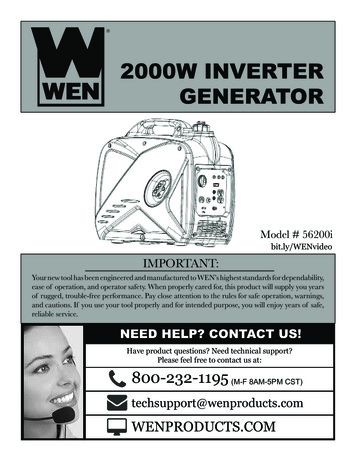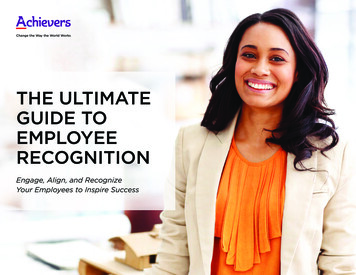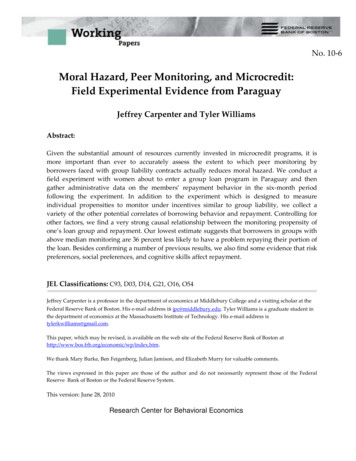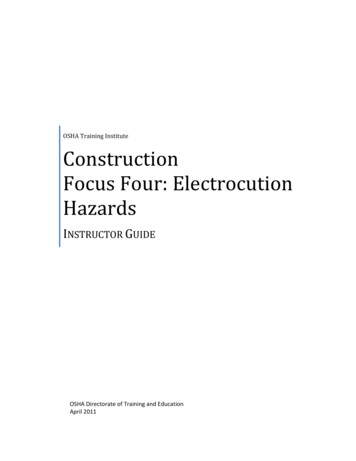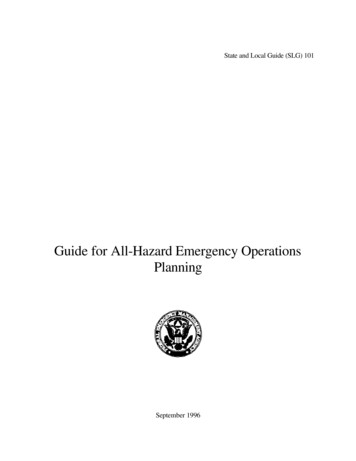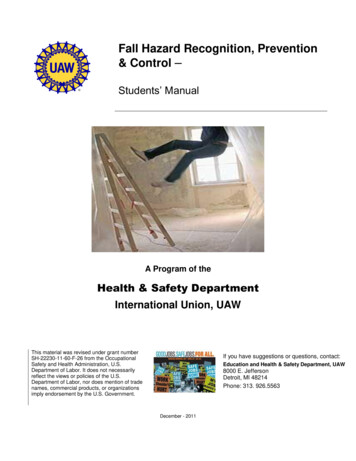
Transcription
Fall Hazard Recognition, Prevention& Control –Students’ ManualA Program of theHealth & Safety DepartmentInternational Union, UAWThis material was revised under grant numberSH-22230-11-60-F-26 from the OccupationalSafety and Health Administration, U.S.Department of Labor. It does not necessarilyreflect the views or policies of the U.S.Department of Labor, nor does mention of tradenames, commercial products, or organizationsimply endorsement by the U.S. Government.If you have suggestions or questions, contact:Education and Health & Safety Department, UAW8000 E. JeffersonDetroit, MI 48214Phone: 313. 926.5563December - 2011
Fall Hazard Recognition, Prevention and ControlCourse GoalCourse Goal – The aim of this program is to provide comprehensive on-site training to high-risk workers (i.e.skilled trades and maintenance workers) and management on Fall Hazards: Recognition, Prevention & Controland the prevention of serious fall injuries at their worksites. Participants will develop an understanding of thehazards associated with falls and how to eliminate or control them.SectionContentIntroduction to FallHazards12IdentifyingPotential FallHazardsFall HazardSolutions3Identifying FallHazard PPE45Action Planningand Course WrapupObjectiveParticipants will be able to: Identify potential factors that contribute to fall hazards. Explain the issues (statistics) associated with falls in the workplace., Describe the intent of a Fall Hazard Identification Program and list theessential elements of an effective program.Participants will be able to: Process for identifying potential fall hazards List types of potential hazards to workers during non-routine maintenancework.o Trip hazards (extension cords, air hoses, tools, etc )o Proximity to fall hazard during work.o Location of work (rafters, tops/sides of equipment, reach, etc )o Slick surfaces (oil, dust, etc )o Lack of proper lightingParticipants will be able to: Identify training requirements for exposure to fall hazardsHierarchy of Health and Safety ControlsTraining Requirements for Rescue at HeightsFixed and Portable Standard RailingsFall Protection PPEParticipants will be able to: Discuss the pros and cons of “restraint devices” and “fall protection”Describe areas where permanent attachment points would be necessaryDescribe the components of fall hazard PPEIdentify the inspection process of all fall PPEParticipants will be able to: Provide assistance to help achieve workplace goal of “Preventing” FallInjuries and Fatalities. Develop “Action Plan” and strategies for implementing a Fall Hazard Programin their facility.2
Fall Hazard Recognition, Prevention and ControlFall Hazard Recognition, Prevention & Control(General Industry)COURSE OBJECTIVESThe goal of this course is to provide small employers and employees with information onrecognizing potential fall hazards at their work sites and suggest ways to avoid, minimize, controlor prevent them. Specifically, this course will: Identify factors that contribute to common fall hazards.Explain how to analyze work areas for fall hazards.Discuss Hierarchy of Health and Safety Controls for fall hazards.Describe OSHA regulations and resources addressing fall protection.3
Fall Hazard Recognition, Prevention and ControlINTRODUCTIONWe have all heard the expression - ‘it’s not the fall that’s hurts but the sudden stop at the end’.Think of a fall as “ a sudden, unanticipated descent in space driven by gravity”. Although thismay not sound severe, the consequences are often disabling - or deadly. It takes most peopleabout 1/3 of a second to become aware of a fall. It takes another 1/3 of a second for the bodyto react. A person can fall up to 7 feet in 2/3 of a second.Anatomy of a Fall.33 second/2’.67 second/7’1 second/16’4
Fall Hazard Recognition, Prevention and ControlIn 2006, the Bureau of Labor Statistics (BLS) reported that fatal work injuries involving fallsincreased 5 percent in 2006 after a sharp decrease in 2005. The 809 fatal falls in 2006 wasthe third highest total since 1992, when the fatality census began. Fatal falls from roofsincreased from 160 fatalities in 2005 to 184 in 2006, a rise of 15 percent. Falls from laddersand roofs still account for the majority of falls. Identifying fall hazards and deciding how best toprotect workers is the first step in reducing or eliminating fall hazards. The US Department ofLabor (DOL) lists falls as one of the leading causes of traumatic occupational death,accounting for eight percent of all occupational fatalities from trauma. Any time a worker is at aheight of four feet or more, the worker is at risk and needs to be protected.2000—March, 2008 UAW “Fall” FatalitiesNovember 16, 2000 – Michael Spears; 28 years old, Grounds Maintenance Worker, 6 yearsseniority, Chrysler Proving Grounds, Chelsea, Michigan; LU 1284; Region 1A; The victimfell off of the back of a truck as he was picking up traffic cones from the driving course.March 7, 2002 – John Aue; 52 years old; Millwright (S/T); 32 years seniority; Federal Mogul;Sparta, MI; LU, Region 1D. The victim was checking for leaking bags in an unlighted dustcollector with an ultraviolet (black) light, when he fell 30 feet down an unguarded 60-inchclean air duct.July 30, 2002 – Samuel R. Heckman: 55 years old, Refrigerator and Air ConditioningMaintenance Journeyman (S/T); 34 years seniority (24 years in classification); GM AllisonTransmission, Indianapolis, IN; LU 933, Region 3. The victim was repairing a fan on the roofwhen he stumbled backwards and fell over a parapet wall, falling 20 feet to his death.September 2, 2002 – Harold Moyle; 64 years old; Electrician (S/T) 31 years seniority;General Motors; Linden, New Jersey; LU 595, Region 9. The victim fell 8’4” through a dropceiling panel down to a steel floor adjacent to a paint spray booth. The victim was assigned torepair lights and apparently was tracking electrical lines. Access to the space was by a fixedladder. There was no lighting in the space and it does not contain safe working platforms. Theceiling panel the victim fell through was not secured to any structural beams.October 30, 2003 - Douglas A. Mellom; 44 years old; Millwright (S/T); 25 years seniority;General Motors; Janesville, Wisconsin; Local 95, Region 4. The victim was on the roof of afreight elevator realigning the safety gate. After he had aligned the gate and as he wasattempting to enter the access opening to return to ground level, he fell over the edge of theelevator roof 18 feet to the floor below.November 22, 2003 – Jeff West; 44 years old; General Welder (S/T); 13 years seniority;Ford Motor Company; Dearborn, Michigan; Local 600, Region 1A. The victim fellapproximately twenty (20) feet to a basement area during the installation of a stampingmachine. He had received numerous injuries including head injuries and died on December22, 2003.5
Fall Hazard Recognition, Prevention and ControlJuly 16, 2005 – Wayne Mueth (died 7/17/05), 42 years old, Millwright (S/T), 21 yearsseniority, DaimlerChrysler, Fenton, Missouri, LU 110, Region 5. Victim was ejected from awork platform basket elevated on hi-lo forks while pulling conveyor chain, which was attachedto the basket. Investigation indicates that a weld securing the restraining chain attaching thebasket to the mast failed, causing the basket to slide on the forks and then fall.February 26, 2006 (deceased April 3, 2006) - Michael A Kruszka; 57 years old; Millwright,38 years seniority; DaimlerChrysler Sterling Stamping Plant, Sterling Heights, Michigan, LU1264, Region 1. The victim suffered a head injury after falling five feet from a temporarymaintenance platform in a press basement while securing a cushion to a press.January 16, 2007 – James Bains: 64 years old; Electrician; 6 years seniority; CC Metal andAlloys; Calvert City, Kentucky; LU 523, Region 3. The victim was found mortally injured nearthe base of a manlift vertical conveyor used to travel up and down 4 levels of an electric arcfurnace. He had apparently fallen while descending on the manlift. The victim had beenassigned to change light bulbs at the top of the eight story furnace and was working alone atthe time of the incident. The victim fell from the 8th floor to 4th floor, a distance ofapproximately 66 feet.March 13, 2008 – Hiram Torres: 61 years old; Warehouse Worker; 9 years seniority; JoseSantiago; Catano, Puerto Rico; LU 3401, Region 9A. The victim was assigned as a helper todeliver food products and materials to a second floor cafeteria at a customer location. Hisnormal job was in the warehouse and he was filling in for the regular worker that day. Thedriver and victim unloaded material from the delivery truck, placed it on a powered lift platformusing a two-wheeled hand truck, closed the lift doors and activated the lift. Both workerswalked to the second floor and opened the lift doors to unload materials. The victim steppedonto the lift platform to position himself behind the hand truck and fell through an unguarded28” x 78” opening between the lift platform and the back wall. The second floor area has poorlighting and this was both workers first time delivering to this location.Fall protection must be provided at four feet in general industry. However, regardless ofthe fall distance, fall protection must be provided when working over dangerousequipment and machinery. Studies have shown that the use of guardrail systems, fall arrestsystems, safety nets, covers, and restraint and positioning device systems can prevent manydeaths and injuries from falls.In this course, we will look at some of the factors that cause fall accidents and fatalities ingeneral industry. We will also look at how to analyze the work area for fall hazards and providesuggestions to prevent fall accidents, injuries and fatalities.This course is designed to assist in identifying, evaluating, preventing and protecting you fromthe harmful results of exposure to fall hazards at your work site.Identifying Fall HazardsA fall hazard is anything in the workplace that could cause an unintended loss of balance orbodily support and result in a fall. Fall hazards cause accidents such as the following:6
Fall Hazard Recognition, Prevention and Control A worker walking on top of an elevator to return to the inside of the elevator falls offunguarded side into the elevator shaft. A makeshift scaffold with no rails or fall protection results in a 5 foot fall leaving one dead. A worker falls through a 60” open pipe 30’ to his death.Fall hazards are foreseeable. You can identify them, eliminate exposure to them, eliminatethem or control them before they result in injuries or death. Some of the factors that contributeto fall accidents and fatalities include: scaffolds; ladders; roofs; tops of equipment and otherelevated work surfaces.Ladders - BLS data show that each year falls from ladders account for approximately 100fatalities each year. Factors that contribute to falls from ladders are ladder slip (top or bottom),overreaching, slipping on rung/steps, defective equipment, and improper ladder selection for agiven task. One of the most frequently cited OSHA ladder violation includes not securing aportable ladder or having it extend 3 feet above the landing before workers use it to reach anupper level.Falls from a Floor (One Level to the Next) – falls to a lower level is one of the major causesof fatalities. Factors such as improperly covered/protected floor holes are a common fallhazard. It is very easy to step backwards into them or step into them when carrying somethingthat blocks one’s forward view.Analyzing Work Areas for Fall Hazards.Analyzing the work area is another important step in fall hazard prevention.Analyzing the work area may include: reviewing blueprints before work begins; anticipatingupcoming fall hazards as work progresses; reviewing current hazards on the site, anddeveloping a pre-planning checklist.Review Blueprints Before Work BeginsOne of the first steps in analyzing the work area should be the review of the blueprints beforework ever begins on the site. By addressing fall hazards at this stage, the employer will bebetter prepared to eliminate the fall hazard or provide fall protection to the employees. Thefollowing are suggestions to assist employers in identifying those areas to address. At any stage of the job will there be unprotected sides/edges, floors, roof, vertical faces, andopen sided floors where a fall hazard exists, if so, here are some options: Change sequence to remove hazards or exposuresRestrict employees from areaCan guardrails be used?Can safety nets be used?If guardrails or nets cannot be used, will personal fall arrest or restraining systems,controlled accessed zones, monitoring systems, warning line systems, and positioningdevice systems be employed? Will employees be exposed to floor, or roof opening? If so, will protection be provided? Is there the possibility of employees being struck by falling objects, if so, will protection beprovided?7
Fall Hazard Recognition, Prevention and Control Are scissors or aerial lifts required? And is there a system in place to ensure properinspection and maintenance of these systems? Are operations such as equipment maintenance, roofing, HVAC installation, etc., addressedahead of time in order to provide fall protection? Is there a fall protection policy in place such as: Vertical life lines Other work methods such as installation from aerial lifts Are there structural member adequate to meet the requirements for anchor points withpersonal fall arrest systems?Anticipate Upcoming Fall Hazards as Work Progresses Additionally, unique fall hazards should be addressed before any exposure.The safety director or site fall protection competent person never wants to be caught off guardwith surprise hazards or exposures. To avoid, what is known as putting out fires, theseindividuals must always be prepared. One method is to review the job for the fall hazards thatwill be present in the future. The following should assist in addressing this issue:1. Review the blueprints for upcoming processes/hazards.2. Discuss the work process with the maintenance manager, superintendents and workers toidentify where new hazards may develop.3. Ask the foreman for assistance in recognizing what hazards may develop in the future.Review for Current Hazards on SiteIf the job has already progressed beyond the point where review of the blueprints will not beeffective, then the site must be reviewed for current hazards. The review for current hazardswill allow the fall protection competent person to address the fall exposures in order toeliminate or minimize the hazard.Pre-Planning ChecklistAn important aspect of fall hazard prevention is planning. An assessment of all fall hazards,even potential fall hazards, must be done before appropriate corrective measures areconsidered. In addition, a fall hazard assessment can also determine training needs and fallrescue methods.If proper planning isn’t done at the onset, time and materials will be wasted and, consequently,unexpected costs will rise. More importantly, fatalities and severe injuries have resulted fromsimply not making the time or effort to effectively identify and control fall hazards.The following is a checklist to assist you in your efforts to pre-plan for fallprevention/protection.It is preferable that this checklist be used before any designing or work begins to be mosteffective in eliminating falls and related hazards.1. Begin the process by identifying those areas where exposure to falls will or already doexist such as: ScaffoldsLaddersRoof and roof openings including skylights8
Fall Hazard Recognition, Prevention and Control Open sided floors and floor openingsStructural framingAerial lift platformsTops of equipmentPermanent and temporary working platformLeading edgeHoist areasRamps, runways and walkwaysWall openingStairwaysWorking over dangerous equipmentPotential for falling objectsHousekeeping concerns2. Do you have a written fall protection program?3. If the work has not begun, or is in progress, have you surveyed the site to identifywhere/what the fall hazards are on the job?4. Is it possible to provide or install fall prevention/protection measures before there is anexposure? Some possible examples include:a. Install guardrails before allowing workers on the floor.b. Install safety nets, stanchions, lifelines to structural steel before members are liftedinto place.c. Don’t cut floor opening until prepared to fill with specified object.d. Attach a self-retracting lanyard or work platform with standard railing to the top ofequipment during installation.5. Is there a competent person on site for fall protection (Required by ConstructionStandards)?6. Does the person understand the fall protection standard, trained to select the proper fallprotection measures/systems, and understand the differences between the following systemsand their use: Fall prevention.Fall protection.Active fall protection.Passive fall protection.7. Will there be a need for a qualified person?8. Is there an adequate fall protection-training program in place to train employees in the fallprotection measures/systems in place on the site?9
Fall Hazard Recognition, Prevention and Control9. For personal fall arrest systems, are anchor points identified and capable of supporting5,000 pounds per worker or two times the intended impact load? Additionally, have swinghazards been addressed in the anchor point location?10. Has an enforcement policy been established, and if so, is it communicated universally,accepted and enforced?11. Have fallen worker rescue methods and procedures been addressed?12. Are employees trained to work at heights safely?13. Have other work methods been proposed or implemented such as:a. Working from aerial or scissor lifts.b. Assembling structures on the ground and lifting them into place, minimizingexposure.c. Installing safety nets under work level or self-retracting lanyards, vertical andhorizontal lifelines materials to be hoisted aloft before the pieces leave the ground andworkers are exposed.d. Installing clamp-on guardrails around roof edge instead of using a warning linesystem.14. Have free fall considerations been addressed including:a. Total free fall clearances are adequate for system in use.b. Employees will not strike lower objects in the event of a fall.c. Employees will not be exposed to forces greater than 1,800 foot lbs. in a full bodyharness10
Fall Hazard Recognition, Prevention and ControlFall Hazard PreventionThe hierarchy of fall hazard control includes: elimination of fall hazards, prevention(Engineering Controls) of falls, and control (Training and PPE) of falls.MOSTEFFECTIVE LEASTEFFECTIVE1. Elimination orSubstitution2. Engineering Controls 3. Warnings 4. Training & Procedures Safe job proceduresSafety equipment & inspectionsRescue at Heights5. Personal ProtectiveEquipment safety harnesses and lanyardsPortable Guard Railschange process to be able toperform task at ground level Install platforms and guard railingUtilize boom or scissor liftsInstall tie offs where work fromheights are necessary.signsElimination of fall hazards is the first and best line of defense against falls from heights. Thisrequires a careful assessment of the workplace and the work process itself. The idea is tocombine safety and health into the work process, and not simply try to add safety as anafterthought to an inherently unsafe work procedure.The prevention of fall hazards is the second line of defense when fall hazards cannot beentirely eliminated. This involves making changes to the workplace to preclude the need torely on the employee’s behavior, and personal protective equipment to prevent falls. Examplesinclude use of stairs, guardrails, and barriers to prevent the employee from direct andunprotected exposure to the fall hazard. These techniques prevent the fall before the onset.Control of falls is the last line of defense. It should be considered only after determining thatthe fall hazard cannot be eliminated or prevented. Fall controls include fall protection such assafety nets or harnesses, and fall arrests. These controls reduce the risk of injury resultingfrom a fall.11
Fall Hazard Recognition, Prevention and ControlActivity: Following the Hierarchy of H&S Controls list these in the order:1. .2. .3. .4. .An Eight Step Approach to Fall ProtectionStep 1 Determine walking/working surfaces are structurally safeStep 2 Conduct a fall hazard assessmentStep 3 Eliminate the need for fall protection, if possibleStep 4 Select the appropriate type of fall protection systemStep 5 Develop rescue/retrieval proceduresStep 6 Develop an equipment inspection, maintenance and storage programStep 7 Provide fall protection trainingStep 8 Monitor the fall protection program12
Fall Hazard Recognition, Prevention and Control“Step 1” Determine if walking/working surfaces are structurally soundDoes the walking/working surface have the strength and structural integrity to safely support allemployees and their equipment?Employees should not be permitted to work on building roofs and other walking/workingsurfaces until the employer has determined that the surfaces are structurally sound.Fall hazards are present everywhere simply because any walking or working surface canprovide them. In addition, many skilled trades workers work at various levels of elevation,increasing the severity of injury.“Step 2” Conduct a Fall Hazard AssessmentKnowing what can immediately contribute to a fall can help in assessing the risk.Working near unguarded edges, lacking safe access, or walking on a slippery or unevensurface are some common examples. A fall hazard assessment greatly helps identify andevaluate these physical fall hazards. Determine which specific jobs, activities or areas expose employees to fall hazards Determine the type of work performed Determine if employees will be exposed to any of the following: Unprotected sides and edges Leading edges Floor holes Wall openings and hoisting areas Slippery surfaces Ramps, runways and other walkways Portable ladders and stairways Working above dangerous equipment Obstructions (materials) Working overhead and related work Roof work Aerial lifts Scaffolds Determine the frequency the work is being performed Determine if workers require horizontal and/or vertical movement Determine the number of workers exposed to a fall hazard (Skilled trades and/or operators) Determine the type of walking/working surface Determine the distance to floor level Determine if the edge of the building or the working surface is protected by a guardrailsystem or parapet wall. If yes, is it adequate? Determine if employees could be exposed to other types of health and/or safety hazards.Can it affect selection or use of fall protection systems?The person conducting the assessment should have some education and/or relevantexperience in order to recognize and evaluate all fall hazards.Furthermore, this person should also have practical knowledge and understanding of fallprotection requirements and other related fall protection methods.13
Fall Hazard Recognition, Prevention and ControlA competent person is someone who is capable of identifying existing and predictable hazardsin the surroundings or working conditions which are hazardous or dangerous to employees,and has authorization to take prompt corrective measures to eliminate them.Various sources of information can be used when conducting the hazard assessmentincluding: Survey employees exposed to the fall hazards Survey affected supervisors & managers Review previous inspections OSHA 300 & 301 records Injury and incident reports Safety committee minutesRemember - involving employees and supervisors in the hazard assessment is essential.They can provide valuable information about where and when fall protection is necessary andideas to possibly eliminate or better prevent fall hazards. Obtaining their input will alsoencourage employees and supervisors to take ownership.If the hazard assessment indicates the need for fall protection, the next step is to determine ifthe fall hazard(s) can be eliminated through engineering controls and/or alternative workmethods. Redesign the process or job task Work at lower heights Use equipment that prevents fall hazards, boom lift, scissor lift and platforms that providebuilt-in fall protection Use tool extensions and work from ground level Lower equipment and tools to ground level Use appropriate aerial lifts“Step 3” Eliminate the Need for Fall Protection if Possible Design buildings and other walking/working surfaces to eliminate/reduce exposurePlanning Comes First!Eliminate– Work from ground– Walls/enclosures– CoversPrevent– Railings– Aerial lifts– Fences/barricades– ParapetsArrest– Personal fall arrest systems– Personal fall restraint systems– Nets– Positioning devices– Roof brackets/slide guards14
Fall Hazard Recognition, Prevention and ControlControl– Safety monitors– Warning lines– Positioning devices– Roof brackets/slide guardsPrevention vs. ProtectionA textbook definition of fall protection could read: “A method to prevent a person from falling orby reducing the distance of a fall to limit physical damage.” Most would agree the first part ofthe above definition addresses fall prevention and is the more preferred strategy.However, reality shows us prevention methods are not always available and in many situationsfall protection is our only option. If the fall hazards cannot be eliminated, the next approach isto select the appropriate fall protection system.Of course, no single fall protection system provides adequate fall protection for all jobactivities. As the type of system will vary from job to job, we must always assess each job andactivity to determine the proper type of fall protection.Consider the following factors when selecting fall protection systems: The distance to lower levels The types of activities requiring fall protection and the specific requirements of each activity The specific types of equipment and components needed with each fall protection How much vertical and horizontal movement employees will need to perform each activity Environmental conditions (i.e. wind, rain, extreme heat/cold) in which fall protectionequipment will be used The potential difficulty of using fall protection systems to perform normal and/or non-routinejob activities The need for anchorage points of suitable design and strength The presence of chemical, electrical, and welding hazards How employees will recover or be rescued from fallen positions The presence of sharp or rough surfaces and edgesStep 4 Select the Appropriate Type of Fall Protection SystemFall Protection Systems and MethodsA fall protection system refers to equipment designed to control fall hazards. All fall-protectionsystems either prevent a fall from occurring or safely arrest a fall.Typical fall protection systems include the following: Personal fall-arrest systems Guardrail systems Safety-net systems Fall restraint system Positioning-device systems Warning-line systems Safety-monitoring systems Controlled-access zonesPersonal fall-arrest systems – consists of an anchor, connectors, and a full body harnessthat work together to stop one from falling and to minimize the arrest force. Other system15
Fall Hazard Recognition, Prevention and Controlcomponents may include a lanyard, a deceleration device, and a lifeline. However, thepersonal fall-arrest system is effective only if you know how all of the components worktogether to arrest the fall.Guardrail systems are vertical barriers consisting of top rails, midrails, and intermediatevertical members. Guardrail systems can also be combined with toe-boards, which are barriersthat prevent materials and equipment from dropping to lower levels.Safety net systems consist of mesh nets, panels, and connecting components.They are typically used as protection for those who work 25 feet or more above lower levels.Fall-restraint system consists of an anchor, connectors, and a body harness or a body belt.Unlike the personal fall-arrest system (designed to stop a fall), the fall-restraint systemsprevent a fall. The fall-restraint system’s anchor must support at least 3,000 pounds.Otherwise, it must be designed, installed, and used under the supervision of a qualifiedperson.Position-device system enables the worker to work with both hands free on a surface suchas a wall or other vertical structure. They are typically used as protection for concrete formwork and placing rebar. The difference between a positioning-device system and a personalfall-arrest system is that the positioning device system supports the worker on an elevatedsurface and limits a fall to two feet.Warning-line systems consist of ropes, wires or chains, and supporting stanchions that forma barrier to warn those who approach an unprotected roof side or edge. The lines mark off anarea which one can do roofing work without using guardrails or safety nets.Safety-monitoring system is a set of procedures assigned to a competent person formonitoring or warning workers who may be unaware of fall hazards.Safety-monitoring systems are appropriate for roofing operations on low-slope roofs less than50 feet wide. A safety monitoring system used in conjunction with a controlled access zoneand a fall-protection plan is also appropriate in situations where conventional fall protection isnot feasible.Controlled-access zones is a work area designated and clearly marked in which certaintypes of work may take place without the use of conventional fall protection systems –guardrail, personal arrest or safety net – to
Fall Hazard Recognition, Prevention and Control 6 July 16, 2005 – Wayne Mueth (died 7/17/05), 42 years old, Millwright (S/T), 21 years seniority, DaimlerChrysler, Fenton, Missouri, LU 110, Region 5.Victim was ejected from a work platform basket elevated on hi-
